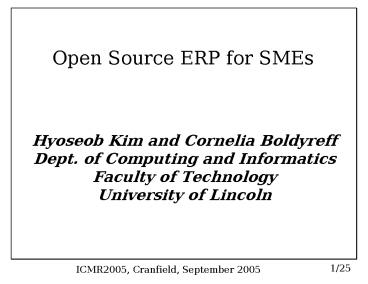Open Source ERP for SMEs - PowerPoint PPT Presentation
1 / 25
Title:
Open Source ERP for SMEs
Description:
ERP attempts to integrate all departments and functions across a company onto a ... Highly positively skewed (kurtosis = 39.05, skewness = 5.70) ... – PowerPoint PPT presentation
Number of Views:458
Avg rating:3.0/5.0
Title: Open Source ERP for SMEs
1
Open Source ERP for SMEs
- Hyoseob Kim and Cornelia Boldyreff
- Dept. of Computing and Informatics
- Faculty of Technology
- University of Lincoln
1/25
ICMR2005, Cranfield, September 2005
2
Contents
- What is ERP?
- Why open Source ERP?
- Market Survey
- Conclusions and Further Work
ICMR2005, Cranfield, September 2005
2/25
3
Current IT Key(Buzz-)words
- ERP (Enterprise Resource Planning)
- CRM(Customer Relationship Management)
- SCM (Supply Chain Management)
- DW (Data Warehouse)
- SEM (Strategic Enterprise Management)
- BPR (Business Process Reengineering)
- BI (Business Intelligence)
- RTE (Real Time Enterprise)
3/25
ICMR2005, Cranfield, September 2005
4
What is ERP? The dream ...
- Evolved from MRP (Material Resource Planning) in
1960s - A term coined by Gartner, Inc. in 1990s
- ERP attempts to integrate all departments and
functions across a company onto a single computer
system that can serve all those different
departments' particular needs - If installed correctly, it can have a tremendous
payback!
4/25
ICMR2005, Cranfield, September 2005
5
SAP Modules
5/25
ICMR2005, Cranfield, September 2005
6
SAP R/3 GUI Screen
6/25
ICMR2005, Cranfield, September 2005
7
SAP R/3 GUI Screen(2)
7/25
ICMR2005, Cranfield, September 2005
8
An Example Order Fulfillment
Before ERP
Problems Delays, lost orders, keying into
different computer systems invites errors
8/25
ICMR2005, Cranfield, September 2005
9
An Example Order Fulfillment(2)
After ERP
Automates the tasks involved in performing
business process
9/25
ICMR2005, Cranfield, September 2005
10
Top Five ERP Vendors
2004 revenue forecast 2004 includes revenue
from J.D. Edwards acquisition Source AMR
Research, 2004
10/25
ICMR2005, Cranfield, September 2005
11
Current Trends
- Consolidation in progress at the top end of the
market due to saturation - The SMEs market and developing countries are the
next battleground. - Small to medium-sized vendors are felling
squeezed. - Deploying the next batch of enterprise
applications, e.g., CRM, SCM, and SEM to generate
new revenues
11/25
ICMR2005, Cranfield, September 2005
12
Small to Medium-Sized Enterprises (SMEs)
an entity that has less than 250 full time
equivalent employees, and has an annual turnover
not exceeding 50 million, or an annual balance
sheet total not exceeding 43 million, and is not
owned by 25 or more by a non-SME
12/25
ICMR2005, Cranfield, September 2005
13
Why Open Source ERP?
- Mad science or a big dotcom business opportunity?
- There is much more to open source software than
Linux. - The availability of open source components, e.g.,
OS, DBMS, Servers - ERP is ubiquitous!
- Pitfalls of COTS-based systems
13/25
ICMR2005, Cranfield, September 2005
14
First we made games, and they said, "Of course
people will make games for free. But they won't
make anything serious and give it away." Then we
made compilers and developer tools, and they
said, "Of course they will make developer tools.
They're developers. But they won't make anything
serious, like an operating system." So, we made
an operating system, and they said, "Of course
they made an operating system. They studied Unix
in school. But they'll never make applications."
Guess what we're making now? Applications. The
next wave of open source is here.
Larry Augustin, Open Source Business Conference,
2005
14/25
ICMR2005, Cranfield, September 2005
15
Survey of Open Source ERP Market
- SourceForge.net, the largest open source software
repository - Had expected a small number of industrial-strength
packages - But found many low-quality packages 129 in
total, majority of these inappropriate for an
industrial use
15/25
ICMR2005, Cranfield, September 2005
16
Ideally
Or
At least
16/25
ICMR2005, Cranfield, September 2005
17
- Highly positively skewed (kurtosis 39.05,
skewness 5.70) - Given enough eyeballs, all bugs are shallow.
Eric S. Raymond
17/25
ICMR2005, Cranfield, September 2005
18
Strong and continuous interest!
18/25
ICMR2005, Cranfield, September 2005
19
- Pearson correlation coefficient rxy 0.20
- What it must not fail to do is (a) run, and (b)
convince potential co-developers that it can be
evolved into something really neat in the
foreseeable future. Eric S. Raymond
19/25
ICMR2005, Cranfield, September 2005
20
- It's fairly clear that one cannot code from the
ground up in bazaar style. Eric S. Raymond - rxy 0.26
20/25
ICMR2005, Cranfield, September 2005
21
t-Tests
- Divided projects into corporate-sponsored ones
and independent ones - Conducted t-Tests w.r.t. no. of developers,
lifespan, CVS activities, and downloads - Not significant statistical differences between
the means of these two groups - Being small, these companies' influences might
have been minimal.
21/25
ICMR2005, Cranfield, September 2005
22
An Example t-test for the CVS activities
22/25
ICMR2005, Cranfield, September 2005
23
Chi-Square Test
- Checked whether each project has released files
- Qualitative data (Yes/No)
- df 1, X2 18.46, alpha 0.05, critical value
3.84 - Statistically significant
23/25
ICMR2005, Cranfield, September 2005
24
Conclusions and Further Work
- EISs as the next wave of open source
applications - Fierce competition expected in the ERP market
geared for SMEs - Originating an OSS ERP project in the bazaar
style is not recommended! - New business model for software software as
service, e.g., consulting, customising and
maintenance - Some SMEs ERP vendors will open their source to
increase market share.
24/25
ICMR2005, Cranfield, September 2005
25
Conclusions and Further Work(2)
- Investigating the developers' various
characteristics, e.g., why do developers want to
start their own projects rather than joining
existing ones? - Surveying customers' needs Know your
customers' needs - Looking into the evolutionary pattern of OSS ERP
packages
25/25
ICMR2005, Cranfield, September 2005































